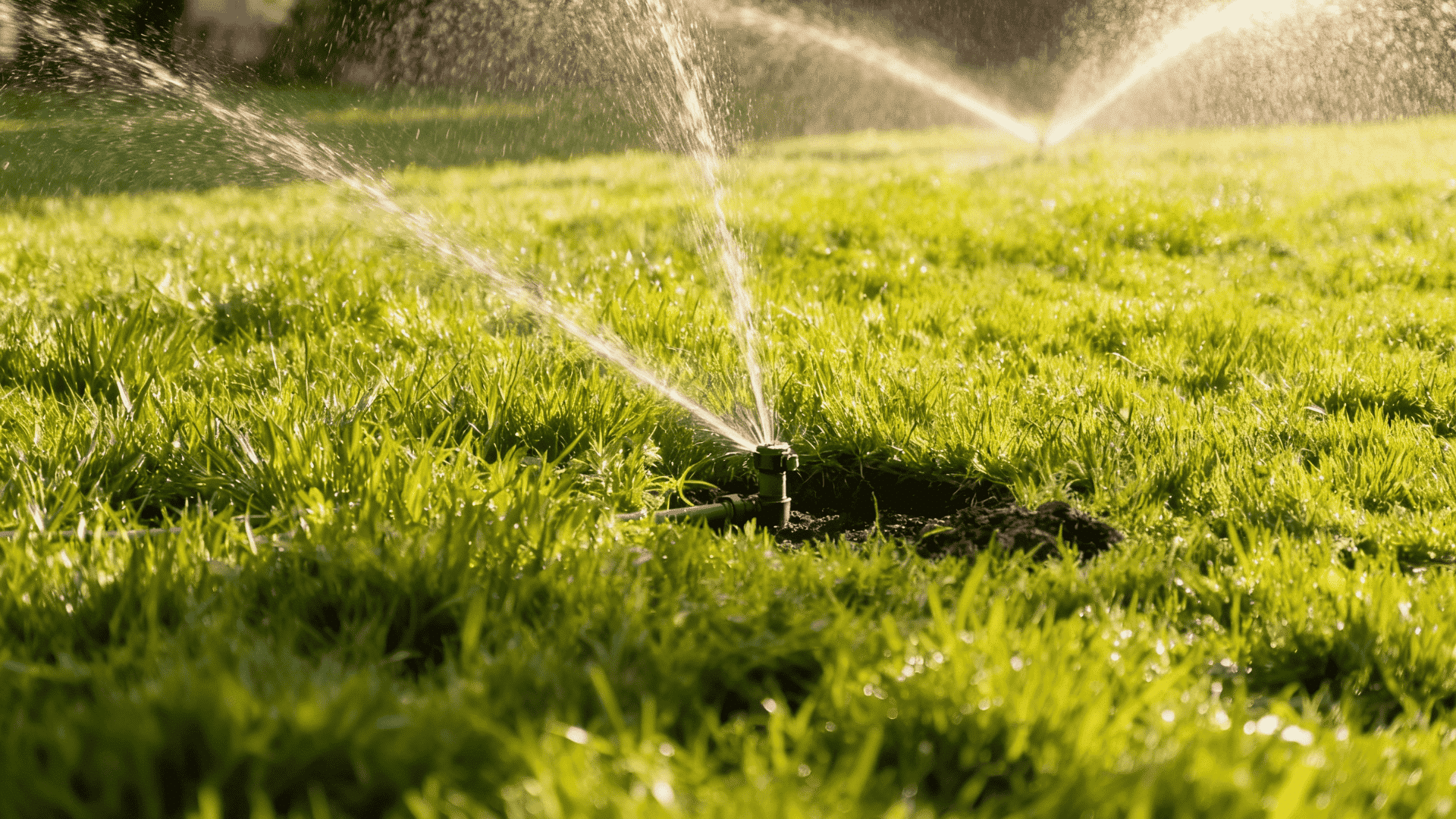Growing a lush, green lawn starts with one critical proper watering is key, but many struggle with overwatering or underwatering newly planted grass seed, leading to patchy growth or complete failure.
The secret lies in knowing exactly how often to water grass seed and following a consistent schedule. Timing makes all the difference between bare patches and a carpet-like lawn.
The readers will learn about the ideal watering routine, from the first sprinkle until seedlings become strong turf. With the right approach, anyone can achieve thick, healthy grass that changes their yard.
Pre-Planting Watering: The Often Forgotten Step
Before scattering a single seed, the soil needs proper moisture preparation. Watering the ground one to two days before planting helps create the ideal environment for germination.
The soil should feel damp about 3-4 inches deep, similar to a wrung-out sponge. This pre-watering step softens hard, compacted earth and allows seeds to make better contact with moist soil.
Many people skip this stage and wonder why their grass struggles to sprout.
Starting with hydrated soil means seeds can begin absorbing water immediately after planting, cutting germination time by several days.
Watering Schedule for All Grass Stages

Understanding how often to water new grass seed at each growth stage prevents common mistakes, such as fungal diseases or dried-out seedlings.
The schedule below breaks down the exact watering needs for every phase.
Week 1-2: Germination Phase
The germination stage requires the most attention and moisture. Seeds need consistent dampness to crack open and send out their first roots. This critical period determines whether the lawn will grow thick or patchy.
- Frequency: 2-3 times daily
- Duration: 5-10 minutes per session
- Best Timing: Early morning, midday, and late afternoon
- Best Tools: Oscillating sprinkler or misting nozzle
Week 3-4: Seedling Establishment
Young seedlings develop deeper roots during this transition period. Reducing watering frequency encourages roots to grow downward in search of moisture. The grass blades become more visible and start thickening.
- Frequency: Once daily
- Duration: 10-15 minutes per session
- Best Timing: Early morning (6-10 AM)
- Best Tools: Rotary sprinkler or garden hose with spray attachment
Week 5-6: Root Development
Grass transitions from delicate seedlings to stronger plants. Roots reach deeper into the soil, and the lawn can handle less frequent watering. This stage prepares the turf for regular maintenance.
- Frequency: Every other day
- Duration: 15-20 minutes per session
- Best Timing: Early morning before 10 AM
- Best Tools: Impact sprinkler or in-ground irrigation system
Week 7+: Mature Grass Maintenance
Established grass no longer needs babying and follows standard lawn care practices. The roots have grown deep enough to access moisture reserves. Most lawns at this stage can withstand brief dry periods.
- Frequency: 2-3 times per week
- Duration: 20-30 minutes per session
- Best Timing: Early morning (best) or evening
- Best Tools: Any sprinkler type or irrigation system
Following this schedule ensures the grass seed Gets exactly what it needs at each growth stage by adjusting watering frequency based on development preventing overwatering young sprouts or underwatering maturing lawns.
Factors That Change Your Watering Schedule

Several environmental and soil factors determine how often to water new grass seed in any specific yard. Smart people adjust their routines based on these conditions rather than blindly following a generic plan.
- Soil Type: Clay soils hold moisture longer and need less frequent watering, while sandy soils drain quickly and require daily sessions
- Sun Exposure: Full-sun areas dry out faster than shaded spots, sometimes needing twice as much water throughout the day
- Wind Conditions: Breezy locations evaporate moisture rapidly, forcing gardeners to add extra watering sessions or increase duration by 5-10 minutes
- Grass Variety: Cool-season grasses like fescue need more water than warm-season types such as Bermuda or zoysia during establishment
- Slope and Drainage: Sloped yards shed water downhill before seeds can absorb it, requiring shorter but more frequent watering to prevent runoff
These factors work together, not separately, so lawns might need multiple adjustments simultaneously. Testing soil moisture with a finger or screwdriver helps determine if changes are necessary.
The Importance of Mulch or Straw Cover for Grass Seed
Covering planting grass seed with a light mulch or straw layer is a crucial but often overlooked step in lawn care.
This natural cover acts as a protective barrier, helping retain soil moisture by reducing evaporation and ensuring seeds stay consistently damp for faster, more even germination.
Mulch also regulates soil temperature by insulating it against extreme heat and cold, creating an ideal environment for seedlings to grow.
Furthermore, it prevents seeds from being washed away by heavy rain or blown off by wind, maintaining seed placement for uniform growth.
An added benefit is that mulch or straw deters birds and animals from eating seeds, protecting your investment.
For best results, apply a thin, even layer about 1-2 inches thick to optimize moisture retention and seed protection without restricting sunlight or airflow.
Seasonal Watering Schedule for Different Grass Types
Weather patterns change throughout the year, and watering schedules must adapt accordingly. Understanding how often to water grass seed in different seasons prevents waste while keeping new lawns healthy.
| Month | Frequency | Duration | Key Adjustment and Grass Type Notes |
|---|---|---|---|
| March – April | Daily | 10-15 minutes | Cool-season grasses (fescue, ryegrass) begin active growth and require steady moisture. Warm-season grasses remain mostly dormant, so water minimally. |
| May – June | 1-2 times daily | 15-20 minutes | Peak growing period for both grass types. Warm-season grasses (Bermuda, zoysia) grow faster and require more frequent watering. Cool-season grasses grow with consistent moisture but avoid overwatering. |
| July – August | 2-3 times daily | 10-15 minutes | Warm-season grasses are at their peak and often require light, frequent watering to prevent heat stress. Cool-season grasses may enter summer dormancy and need less water. |
| September – October | Every other day | 15-20 minutes | Cool-season grasses revive and increase water intake to build winter reserves. Warm-season grasses start slowing growth; decrease watering frequency. |
| November – February | 2-3 times weekly | 10 minutes | Both grass types reduce watering needs. Water sparingly during cold months unless experiencing dry spells. |
Signs Your Grass Seed Watering Is Working
Knowing whether the watering schedule is effective saves time and prevents costly mistakes. Healthy grass seed shows specific visual signs that indicate proper moisture levels.
- Visible Sprouting: Green shoots appear within 5-14 days, depending on grass type, with cool-season varieties sprouting faster than warm-season ones
- Even Growth Pattern: Grass emerges uniformly across the entire seeded area without bare patches or concentrated clumps in random spots
- Moist Soil Surface: Top layer stays damp between watering sessions, feeling cool to the touch but not muddy or forming puddles
- Strong Root Development: Gentle tugging shows resistance from established roots anchoring into soil, indicating seedlings have moved past the fragile stage
- Vibrant Color: Seedlings display bright green blades rather than yellow or brown tips, signaling they’re receiving adequate hydration and nutrients
These signs confirm the watering routine is delivering results. Missing one or two indicators might signal that minor adjustments are needed.
Practical Watering Tips to Improve Lawn Germination
Small adjustments to watering habits can dramatically improve germination rates and lawn quality. These practical tips help avoid common pitfalls that ruin otherwise good seeding efforts.
- Water in the morning hours to reduce evaporation and prevent fungal diseases from overnight moisture
- Check soil moisture by pressing a finger 1-2 inches deep before each watering session
- Avoid puddling by using gentle spray settings that don’t wash seeds away or create runoff
- Mark dry spots with stakes to remember areas needing extra attention during watering rounds
- Reduce wind interference by watering when conditions are calm, typically early morning or evening
- Keep traffic minimal on newly seeded areas since footprints compress soil and disrupt water absorption
Conclusion
Mastering how often to water grass seed changes bare soil into a thriving green carpet. The watering schedule evolves from multiple daily sessions during germination to weekly maintenance once roots establish.
Soil type, weather patterns, and grass variety all influence the perfect routine for any lawn.
Avoiding common mistakes, such as nighttime watering or inconsistent schedules, prevents disease and patchy growth.
Success requires patience and observation during those critical first six weeks. People who adjust their approach to growth stages achieve dramatically better results than those who use rigid schedules.






